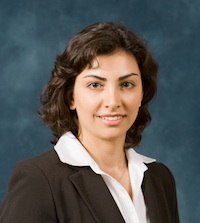New Frontiers in Terahertz Technology
Although unique potentials of terahertz waves for chemical identification, material characterization, biological sensing, and medical imaging have been recognized for quite a while, the relatively poor performance, higher costs, and bulky nature of current terahertz systems continue to impede their deployment in field settings. In this talk, I will describe some of our recent results on developing fundamentally new terahertz electronic/optoelectronic components and imaging/spectrometry architectures to mitigate performance limitations of existing terahertz systems. In specific, I will introduce new designs of high-performance photoconductive terahertz sources that utilize plasmonic nanoantennas to offer terahertz radiation at record-high power levels of several milliwatts – demonstrating more than three orders of magnitude increase compared to the state of the art. I will describe that the unique capabilities of these plasmonic nanoantennas can be further extended to develop terahertz detectors and heterodyne spectrometers with quantum-level detection sensitivities over a broad terahertz bandwidth at room temperatures, which has not been possible through existing technologies. To achieve this significant performance improvement, plasmonic antennas and device architectures are optimized for operation at telecommunication wavelengths, where very high power, narrow linewidth, wavelength tunable, compact and cost-effective optical sources are commercially available. Therefore, our results pave the way to compact and low-cost terahertz sources, detectors, and spectrometers that could offer numerous opportunities for e.g., medical imaging and diagnostics, atmospheric sensing, pharmaceutical quality control, and security screening systems. And finally, I will briefly highlight our research activities on development of new types of high-performance terahertz passive components (e.g., modulators, tunable filters, and beam deflectors) based on novel reconfigurable meta-films.
Date and Time
Location
Hosts
Registration
-
 Add Event to Calendar
Add Event to Calendar
Loading virtual attendance info...
- Contact Event Hosts
- Co-sponsored by Dr. Mehrdad Sharbaf IEEE CLAS Computer Society Chair, Adjunct Professor CSUDH
Speakers
Professor Mona Jarrahi
New Frontiers in Terahertz Technology

Biography:
|
Professor Mona Jarrahi
Professor and Northrop Grumman Endowed Chair Mona Jarrahi received her B.S. degree in Electrical Engineering from Sharif University of Technology in 2000 and her M.S. and Ph.D. degrees in Electrical Engineering from Stanford University in 2003 and 2007. She served as a Postdoctoral Scholar at University of California Berkeley from 2007 to 2008. After serving as an Assistant Professor at University of Michigan Ann Arbor, she joined University of California Los Angeles in 2013 where she is currently a Professor and Northrop Grumman Endowed Chair in Electrical and Computer Engineering and the Director of the Terahertz Electronics Laboratory. Prof. Jarrahi has made significant contributions to the development of ultrafast electronic and optoelectronic devices and integrated systems for terahertz, infrared, and millimeter-wave sensing, imaging, computing, and communication systems by utilizing novel materials, nanostructures, and quantum structures as well as innovative plasmonic and optical concepts. The outcomes of her research have appeared in more than 300 publications and 270 invited talks and have received a significant amount of attention from scientific news outlets including Huffington Post, Popular Mechanics, EE Times, and IEEE Spectrum. Her scientific achievements have been recognized by several prestigious awards including the Presidential Early Career Award for Scientists and Engineers (PECASE); Friedrich Wilhelm Bessel Research Award from Alexander von Humboldt Foundation; Moore Inventor Fellowship from the Gordon and Betty Moore Foundation; A F Harvey Engineering Research Prize from the Institution of Engineering and Technology (IET); Kavli Fellowship by the USA National Academy of Sciences (NAS), Grainger Foundation Frontiers of Engineering Award from the USA National Academy of Engineering (NAE); Breakthrough Award from Popular Mechanics Magazine; Research Award from Okawa Foundation; Innovations in Regulatory Science Award from the Burroughs Wellcome Fund; Harold E. Edgerton Award in High-Speed Optics from the International Society for Optics and Photonics (SPIE); Early Career Award in Nanotechnology from the IEEE Nanotechnology Council; Outstanding Young Engineer Award from the IEEE Microwave Theory and Techniques Society; Booker Fellowship from the USA National Committee of the International Union of Radio Science; Lot Shafai Mid-Career Distinguished Achievement Award from the IEEE Antennas and Propagation Society; Early Career Award from the USA National Science Foundation (NSF); Young Investigator Awards from the USA Office of Naval Research (ONR), the Army Research Office (ARO), and the Defense Advanced Research Projects Agency (DARPA); Watanabe Excellence in Research Award from UCLA Henry Samueli School of Engineering and Applied Science; Elizabeth C. Crosby Research Award from the University of Michigan; and Distinguished Alumni Award from Sharif University of Technology. Prof. Jarrahi is a Fellow of the Institute of Electrical and Electronics Engineers (IEEE), Optical Society (OPTICA), International Society for Optics and Photonics (SPIE), American Physical Sosiety (APS), Institute of Physics (IoP), and has served as a distinguished lecturer of IEEE, traveling lecturer of OSA, and visiting lecturer of SPIE societies. |

